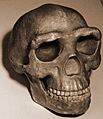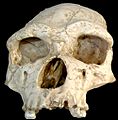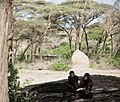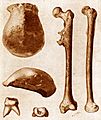Homo erectus facts for kids
Quick facts for kids Homo erectusTemporal range: Pleistocene
|
|
|---|---|
 |
|
| Homo erectus | |
| Scientific classification | |
| Kingdom: | |
| Phylum: | |
| Class: | |
| Order: | |
| Family: | |
| Genus: | |
| Binomial name | |
| †Homo erectus |
|
| Synonyms | |
Homo erectus (which means "upright man" in Latin) was a type of early human that is now extinct. These ancient humans lived about 2 million years ago.
Scientists found their fossil remains in Java in the 1890s and in China in 1921. Sadly, most of these original fossils were lost during World War II. However, we still have casts (copies) of them, which are very helpful for studying Homo erectus.
In the early 1900s, many thought that the first modern humans came from Asia. But later discoveries in the 1950s and 1970s changed this idea. Many fossils found in East Africa (Kenya) showed that the very first hominins (early humans) actually came from Africa.
Contents
What Homo erectus Looked Like
Homo erectus had a larger brain size than an earlier human type called Homo habilis. The oldest H. erectus fossils show a brain size of about 850 cubic centimeters. Newer fossils from Java had brains up to 1100 cubic centimeters. This size is similar to some modern humans.
Their frontal bone (forehead) was not as sloped as older human relatives like australopithecines. Their teeth were also smaller. The face of H. erectus was flatter, not sticking out as much as H. habilis or australopithecines. They also had large brow-ridges above their eyes and less noticeable cheekbones.
These early humans were quite tall, standing around 1.79 meters (about 5 feet 10 inches). Only about 17% of modern men are taller than that. They were also slender, with long arms and legs.
There was a bit more difference in size between male and female Homo erectus than there is in modern humans. Males were about 25% larger than females. A very important discovery was the skeleton known as "Turkana boy" (sometimes called Homo ergaster). Richard Leakey and Kamoya Kimeu found it near Lake Turkana, Kenya, in 1984. This is one of the most complete early human skeletons ever found. It has taught us a lot about how human bodies changed over time.
Tools Used by Homo erectus
The most special tool made by Homo erectus was the Acheulean hand axe. This tool was first made about 1.8 million years ago. They made these hand axes by chipping away at a suitable stone with another harder stone, called a hammer stone.
Later, neanderthals used softer hammers, like those made from deer antler bone, to create even better tools. The Acheulean hand axe was used for over a million years! Its main job was to butcher meat. Scientists know this because different uses leave tiny marks on the tool's surface.
Family Tree: Descendants and Subspecies
Homo erectus was a very successful type of human. It lived for a long time and is thought to be the ancestor of many other human species and subspecies. The oldest known Homo erectus fossil was found in southern Africa.
- Homo erectus (different types):
- Other related species (thought to be descendants or close relatives):
Important Homo erectus Fossils
Here are some of the main places where Homo erectus fossils have been found:
- Indonesia (Java island): Trinil 2, Sangiran, Sambungmachan, Ngandong
- China: Lantian (Gongwangling and Chenjiawo), Yunxian, Zhoukoudian, Nanjing, Hexian
- India: Narmada (scientists are still discussing its exact type!)
- Kenya: WT 15000 (Nariokotome), ER 3883, ER 3733
- Tanzania: OH 9
- Vietnam: Northern, Tham Khuyen, Hoa Binh
- Republic of Georgia: Dmanisi
- Turkey: Kocabas
New Discoveries About Homo erectus
Scientists recently looked again at the age of H. erectus skulls found in Java in the 1930s. There are 12 skullcaps (the top part of the skull) and two lower leg bones. The new research shows that H. erectus survived on Java until about 100,000 years ago. The exact age is between 117,000 and 108,000 years ago.
This is much longer than Homo erectus is known to have survived anywhere else in the world. It means that Homo erectus was still living on Java when our own species, Homo sapiens, was already walking the Earth in other places. Java is an island, and it seems that Neanderthals or our own species did not reach Java until about 39,000 years ago.
Related pages
Images for kids
-
Reconstruction of a specimen from Tautavel, France
-
Java Man at Naturalis
-
Map showing where Middle Pleistocene (Acheulean) cleaver tools have been found
-
Dmanisi skull 3 (fossils D2700 and D2735, found in Dmanisi, Georgian Transcaucasus)
-
Cross sections of Chinese H. erectus humeri (upper arm bones) showing very thick cortical bone
-
Reconstruction of a Terra Amata dwelling (shelter)
-
Replica of lower jaws of Homo erectus from Tautavel, France
-
Original fossils of Pithecanthropus erectus (now Homo erectus) found in Java in 1891
See also
 In Spanish: Homo erectus para niños
In Spanish: Homo erectus para niños




















